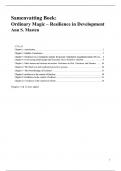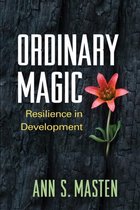Samenvatting Boek:
Ordinary Magic – Resilience in Development
Ann S. Masten
Chapter 11 & 12 now added
1
,Chapter 1: introduction
Intro/history
- The waves of research on child development and resilience were initiated in response to the
challenges children faced during and after World War II. Scientists sought to understand the effects
of adversity on children and adults and identified various risk factors associated with negative
outcomes. This approach aimed to answer questions about who gets affected, why, and how to
reduce the impact of adversity.
However, as researchers studied high-risk children over time, they noticed that many of them were
thriving despite challenging circumstances. This observation led to a shift in focus towards 3
questions about: who stays well and recovers well, how they do it, and how to promote and protect
positive development. Leading scholars in psychology and psychiatry, including Garmezy, Rutter,
and Werner, began to emphasize the importance of these questions, marking the beginning of the
first wave of resilience research.
The four waves
- Resilience science has evolved through four major waves over the past half-century.
1. The first wave focused on defining and measuring resilience and identifying its predictors. It
asked questions like "What is resilience?" and "What makes a difference?"
2. The second wave delved into the processes of resilience, exploring how protective and promotive
factors work and how positive development is fostered in the face of risk.
3. The third wave shifted towards promoting resilience through interventions while testing theories
from the previous waves.
4. The fourth wave, influenced by advances in genetics, neuroscience, and multidisciplinary
integration, explores dynamic, systems-oriented approaches, including genetic differences,
sensitivity to traumatic experiences, and brain development in high-stress environments.
- Throughout these waves, questions have emerged regarding the role of genetics, individual
sensitivity to trauma and positive interventions, and the nurturing of resilience in communities and
societies. The early pioneers in resilience science recognized the importance of understanding
positive outcomes in high-risk children and youth for both practice and policy. After decades of
research, it is now essential to assess the evidence, controversies, and lessons learned in the field to
inform future goals and implications for practice and policy.
- Resilience, the ability to overcome adversity, is not rare or exceptional. It is a common response
that typically arises from basic protective factors rather than extraordinary talents or resources.
- Resilience emerges from commonplace adaptive systems for human development, such as a healthy
human brain in good working order; close relationships with competent and caring adults; committed
families; effective schools and communities; opportunities to succeed; and beliefs in the self,
nurtured by positive interactions with the world.
2
, definition ‘resilience’
- The word resilience stems from the Latin verb resilire (to rebound).
- author defines resilience as follows: The capacity of a dynamic system to adapt successfully to
disturbances that threaten system function, viability, or development.
- With each wave of research on resilience in children, the definitions and models of resilience
became more dynamic. In early work, resilience often was defined in terms of doing well or
avoiding mental illness in the context of risk or adversity. In the behavioural sciences of psychology,
psychiatry, and related fields, the concept of resilience continues to refer generally to positive
adaptation in the context of risk or adversity.
*patterns and pathways of resilience / Resilience trajectories
afbeelding: x = trauma of tegenzittende leefomstandigheden (e.g.
poverty)
- adaptation may fluctuate, but function stays in zone of normal
adaptation.
A. Stress invulnerable or stress resistant
B. trauma followed by recovery (late bloomers)
C. improved rearing conditions (e.g. taken out of orphanage),
major shift or normalization
D. post-traumatic growth, adaptive function improves following
trauma or adversity.
*criteria for resilience, 2 judgements:
Resilience is inferred from two sets of evaluations:
1. the nature of threat posed by their life experiences (has there been risk?)
2. the quality of adjustment or a person’s development (is this person doing okay?).
If there is little or no threat in an individual’s life, or if there is not (yet) evidence of recovery or good
outcome, then there is no observed resilience (at least not yet).
Judging threats to child development and adaptation
Risk factors are established predictors of undesirable outcomes, where there is evidence suggesting
a higher than-usual probability of a future problem.
- i.e. Risk factors are things that can predict bad things happening, like problems in the future,
because these risk factors have evidence showing they make these problems more likely.
- Many of the most common risk factors of childhood predict multiple problems of behaviour, health,
and growth. explanations:
1. Risk predicts risk: risk factors are often related to one another. Where one is, there will more
likely be another. (e.g. where there is poverty, there is likely malnutrition)
2. 1 risk can mean multiple problems: Risk factors could be signs of basic issues that affect not
just one, but multiple aspects of growth and adaptation. (e.g. malnutrition can lead to multiple
problems in growth, brain development and cognition)
3. 1 problem is likely to lead to another: over time, the same risk factor could account for
snowballing problems in multiple domains. (e.g. self-regulation problems early on in school could
have a negative impact later on in school with learning or friendships)
3






